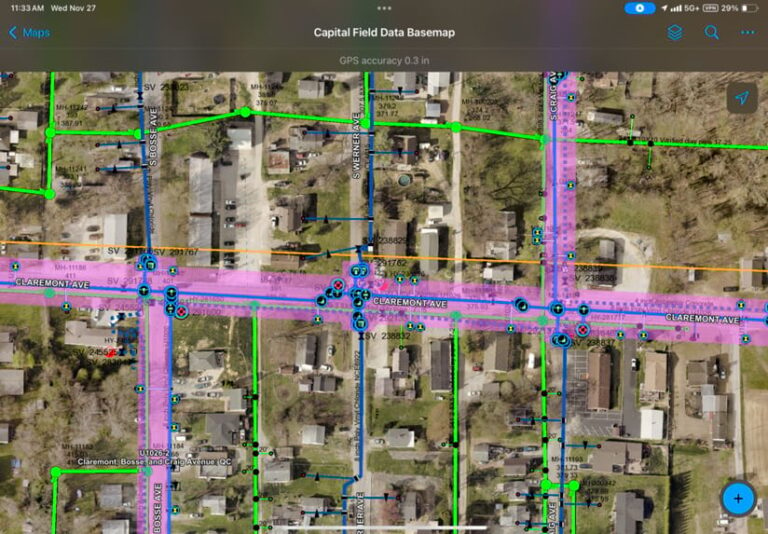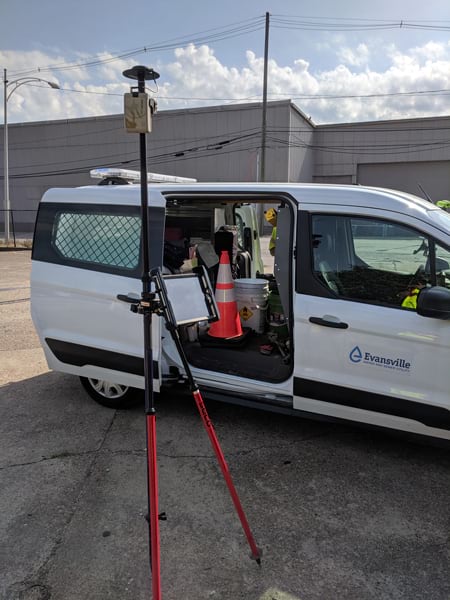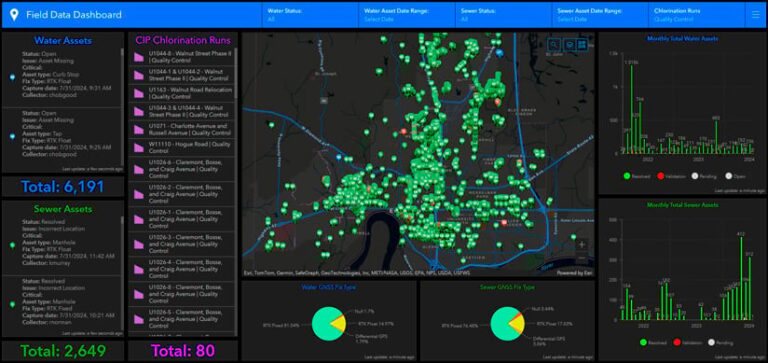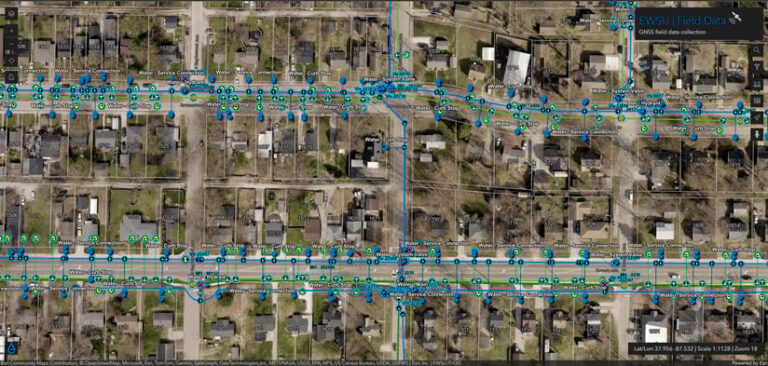Located in Indiana alongside the Ohio River, the city of Evansville is home to roughly 115,000 people. Evansville Water and Sewer Utility (EWSU) is dedicated to providing this community with high-quality, safe, and reliable water and sewer services.
With the retirement of ArcMap and the geometric network, EWSU decided to migrate to ArcGIS Pro and ArcGIS Utility Network. During the transition, staff saw an opportunity to resolve widespread inaccuracies in their existing asset locations.
“As we were thinking about moving to and taking advantage of [ArcGIS] Utility Network, we knew our source data had to be squeaky clean,” said Ryan Key, GIS manager at EWSU.
Taking six months to recapture data with high accuracy became a priority. Inaccurately mapped clusters of infrastructure, such as multiple water meters at one site, had made it difficult to locate individual assets during maintenance, annual inspections, and capital refresh projects.
Additionally, responding to service requests with inaccurate locations often wasted time, with customer service representatives unable to access real-time customer data geospatially.
Meanwhile, capital refresh projects—which target the replacement of aging infrastructure and include design, construction, installation, and final as-built drawings—sometimes experienced project-design delays due to location inaccuracies. As a result, updating EWSU’s GIS environment could often take anywhere from months to a year. The utility’s staff realized that, in addition to preparing EWSU for the migration to Utility Network, remapping and rectifying their asset data could provide a host of additional immediate benefits.
Implementing GNSS Receivers with ArcGIS
As a first step in updating their system, EWSU decided to integrate real-time Global Navigation Satellite System (GNSS) technology. Key had heard about the effectiveness of Arrow Series GNSS receivers from Eos Positioning Systems through a GIS specialist and industry peer. As a firm believer in trying technology before buying it, Key decided to put the receivers to the test.

“I actually went out with our field crew and tested an Arrow receiver alongside some other receivers,” Key said. “We did side-by-side comparisons of the location data, and in the end, Arrow won. Our decision really came down to the accuracy of the Arrow receiver and its quick integration with ArcGIS Field Maps.”
Since EWSU was already using ArcGIS software, integrating the Arrow receivers with ArcGIS Field Maps was a huge advantage. Asset locations in the field can be captured with centimeter-level accuracy, and these positions are instantly synced to ArcGIS Online, making real-time updates accessible from the office. Additionally, the receivers were device agnostic, meaning they could pair with the iOS devices field crews were already using.
“If we’re going to collect data, why not have it as accurate as it could possibly be?” Key said. “When you get tight clusters of things like system valves, that accuracy is important.”
EWSU’s in-house surveyor set up two real-time kinematic (RTK) base stations, which provide the differential corrections needed for centimeter-level accuracy. By connecting the rover receivers to a base station, crews could achieve real-time, high-accuracy results.
“We can cover most of the county with one base station,” Key said. “The second acts as more of a redundancy if one becomes inoperant.”
The EWSU GIS team trains employees new to the technology on the hardware, software configuration, and actual data collection, all of which takes only about an hour. After training, field crews receive a basic user guide for reference. Key noted that crews rarely need follow-up support.

“The cool thing about this [GNSS] technology and the integration with [ArcGIS] Field Maps is that it is super user-friendly,” Key said. “It’s essentially plug and play. A lot of these guys had no GIS experience, and they transitioned to collecting data like ducks to water.”
In the Office
Next, using dashboards created with ArcGIS Dashboards, staff in the office visualize and analyze data collected in the field. Back at his desk, GIS technician Aaron Krohn monitors these dashboards to see data collection as it occurs.
“I can look at everything our crews have collected and see those numbers update in real time,” Krohn said. “They record the type of asset [and] its status as well as the fix type.”
Using ArcGIS Dashboards, Krohn can also respond to edit requests in real time. He can also use the new, accurate locations from the GNSS receivers to correct outdated infrastructure from previous plans.
EWSU also built a custom ArcGIS Utility Network web application, U-Net, by using ArcGIS Maps SDKs. U-Net is a launching point for other teams to access information from GIS-related systems—such as an asset management system, a CCTV application, a customer service portal, as well as historical and as-built drawings—all on a map. Non-GIS teams now use U-Net to view their information geospatially without having to open and navigate desktop GIS software. This expands the reach of GIS to teams that are not GIS professionals.
“We’re truly harnessing the service-driven architecture of Utility Network,” Key said. “It’s easier to send our colleagues a web URL than have everyone in our organization use a desktop GIS, which has too many bells and whistles for someone who wants to dive in and review, for instance, only customer service information on a map.”
To enable this widespread information access, Key and Krohn have been diligently upgrading other systems and data and migrating them onto the cloud.

“Our thought process was, if we’re going to go ahead and do this Utility Network migration, why not go ahead and move other applications to the cloud too?” Key said.
EWSU’s new mobile mapping workflow has resulted in better accuracy in the utility’s asset maps. This, in turn, has streamlined inspections and set a new standard for the utility’s capital-refresh project timelines. EWSU now completes the as-built process in near real time, rather than up to one year later, thanks to field crews being able to map installations during on-site inspections.
“We’ve collected about 9,000 assets in as little as two years,” Key said. “And we can see those on the map in real time—including maintenance holes, system valves, service connections, and other infrastructure assets.”
Access to Utility Network, along with its increased accuracy, has even enabled EWSU staff to expand use of their GIS to contractors, especially those performing 8-1-1 underground-asset location requests for new development.
Looking Ahead
In the future, EWSU plans to leverage tracing tools in Utility Network. Key envisions how this will simplify customer notifications in impact areas. During boil-water advisories, for instance, truck valve operators will no longer have to manually draw a polygon around the impact area. Instead, operators can change the operation mode of a valve at two ends and immediately generate an impact-area polygon directly from their mobile devices. This will be powered by the squeaky-clean data and meticulous cloud environments that EWSU has already created.

“Our field crews who collected this data understand that what they did will ultimately end up making their lives easier in the future,” Key said.
The same workflow can be expanded to engineers to create impact areas for water main replacements, part of the utility’s capital refresh projects.
Key emphasized that all this was made possible thanks to the support of EWSU’s executive leadership. Throughout the utility, there is an understanding that technology enables EWSU to deliver a higher quality of service. That forward-thinking mindset allows the utility to push the boundaries of what is capable in terms of how and why staff serve customers.
“It’s all about customer service,” Key said. “Having this type of accuracy in our system allows for greater response, reaction, and repair—which translates to greater customer experience.”



